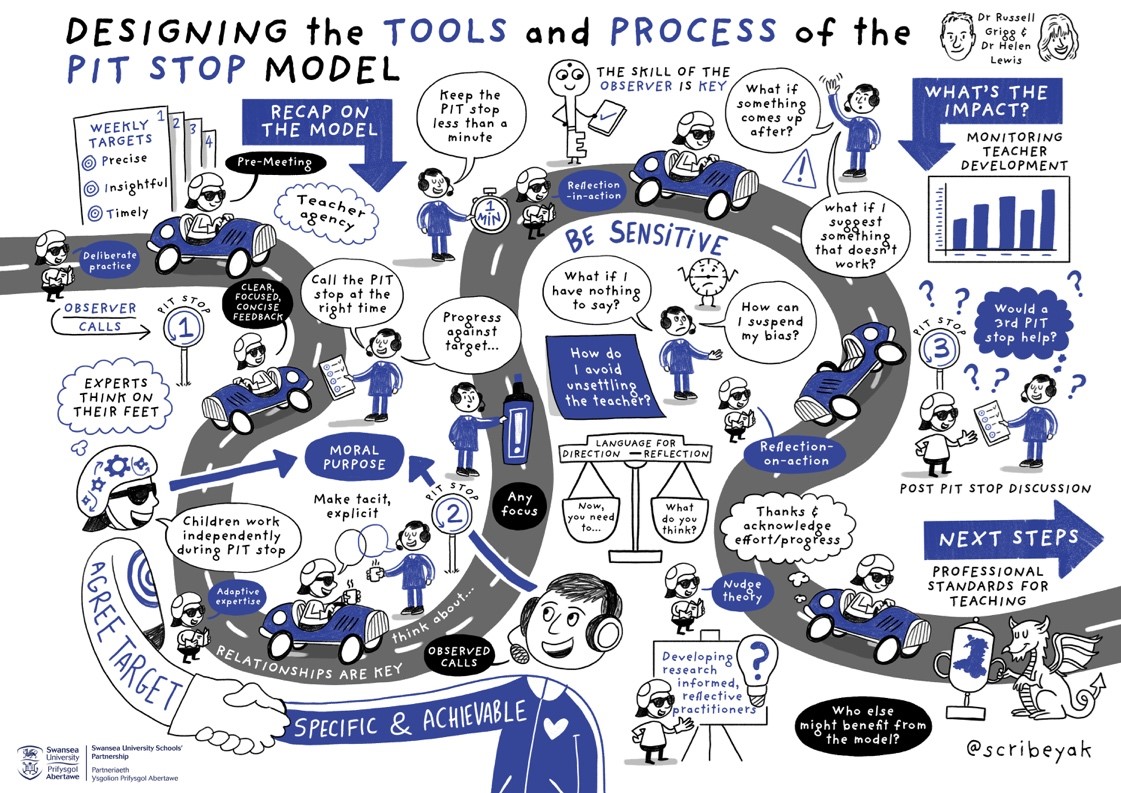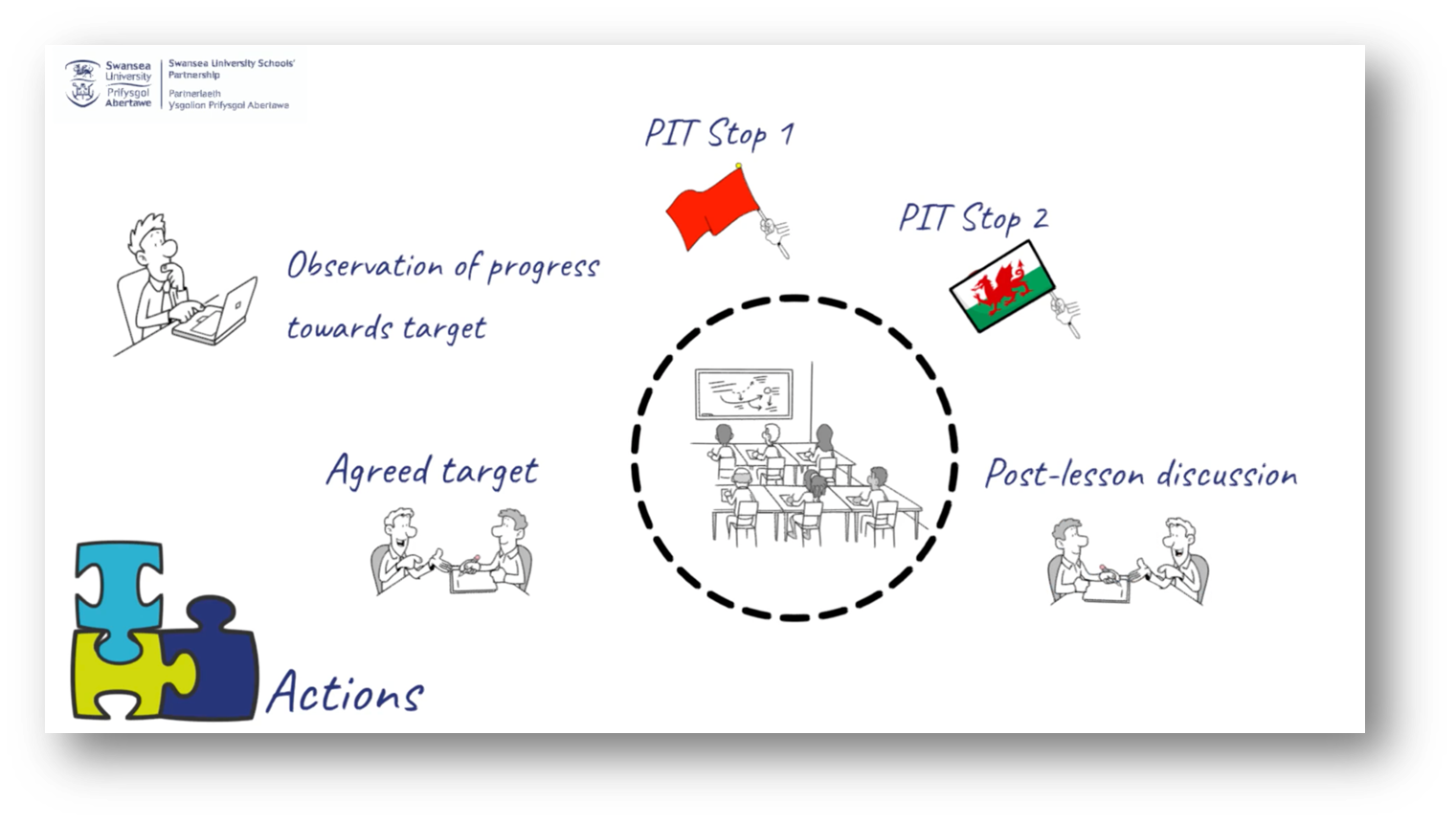By Dr Russell Grigg, Director of Initial Teacher Education and Dr Helen Lewis, PGCE Primary Programme Director.
This year marks the 40th anniversary of Donald Schön's influential publication, ‘The Reflective Practitioner: How Professionals Think in Action’, which has shaped the design of initial teacher education programmes in Wales and beyond. One of the most challenging of Schön's concepts is reflection-in-action, commonly described as thinking-on-your-feet during lessons. This is hard, even for more experienced teachers. But it matters because the ability to think flexibly and make appropriate changes during lessons can make a real difference to what, and how well, both student teachers and children learn.
 At Swansea University, we have recently piloted a model among our primary PGCE student teachers to support such reflection-in-action. It is informed by Schön's seminal work, as well as a range of other theories and concepts.
At Swansea University, we have recently piloted a model among our primary PGCE student teachers to support such reflection-in-action. It is informed by Schön's seminal work, as well as a range of other theories and concepts.
PIT Stop stands for Precise, Insightful and Timely feedback (alternatively described by one of our student teachers as Pause in Teaching). Such feedback takes the form of in-lesson learning conversations between the observing mentor and mentee, each lasting 30-60 seconds and occurring twice during a lesson. One is called by the mentor focusing on an agreed or 'contracted' target beforehand, and the other by student teachers on anything which surprises or puzzles them. Finally, a post-lesson discussion reflects on the impact of these conversations.
The pilot comprised of a cohort of 20 PGCE primary student teachers and one secondary student teacher. Their practice took place in English and Welsh-medium schools, with each student teacher observed once by a trained senior mentor. The sessions were filmed and then shared for comment with both the mentors and student teachers. PIT Stop supplements, rather than replaces, two conventional, formal lesson observations.
The findings were overwhelmingly positive. All of the student teachers strongly agreed that the model added value to their practice and each summed up their thoughts in three words.

In particular, student teachers highlighted the benefits of receiving insightful, formative and actionable feedback as they teach:
‘...the thing that made it really good and helpful is that it was doable’ (Hollie).
‘I think, having that available feedback, and acting on it then, helps you absorb the information more, I think, than the traditional observation [when] you get your feedback at the end’ (Laura).
‘Because of the way that the PIT Stop model works, I think it's just something that is more natural. You do remember the feedback and action rather than the feedback after action’ (Rebekah).
Mentor feedback in PIT Stop 1 can be characterised as advice-giving, akin to coaching, which we feel is developmentally appropriate. The observers received training on the model and how to provide brief, focused feedback.
Student teachers tended to use PIT Stop 2 to 'check in' and seek reassurance that they were on the right lines. In a few cases, student teachers took the opportunity to explain their decision-making. Rebekah was one of the few who engaged in the kind of reflective questioning and the signalling of experimenting which Schön envisaged. Surprised that her lesson was not going to plan, she called a PIT Stop to explain that she was about to change direction. It takes confidence, trust, and familiarity with a new way of working to engage with such in-the-moment reflective conversations.
PIT Stop is not without its challenges. A couple of student teachers forgot to call their PIT Stops and there was occasional misunderstanding. For example, one mentor found that although the student teacher nodded in agreement with the feedback around positive reinforcement and appeared to understand the suggestions, these were not applied. We concluded that live modelling could be included as a strategy to support student teachers in such cases.
When we brought the observers and observed together to evaluate the project, we had no shortage of further questions to explore. Some of these related to logistical issues (e.g., ‘Could we vary the number of PIT Stops?’) and others were more theoretical (e.g., ‘What is the role of emotions in reflection?’). We agreed upon some non-negotiables in moving forward (e.g., the need for mentor training, a preliminary and post-lesson meeting, and agreed target) and where we could be flexible (e.g., the order of the PIT Stops). We then formulated guidance to support the wider dissemination of the model and created outputs such as animations and posters to convey key messages in an accessible format.
 There was unanimous agreement that the success of PIT Stop rests on relationships between mentor and mentee, the quality of questioning and interaction, framing the dialogue around a developmental, non-judgemental narrative, and close liaison between university and partner schools. The post-lesson discussion was key to facilitating reflection-on-action.
There was unanimous agreement that the success of PIT Stop rests on relationships between mentor and mentee, the quality of questioning and interaction, framing the dialogue around a developmental, non-judgemental narrative, and close liaison between university and partner schools. The post-lesson discussion was key to facilitating reflection-on-action.
PIT Stop is conceived as a form of ongoing professional enquiry rather than conventional assessment of school-based teaching experiences. This aligns with our vision to develop research informed, reflective practitioners. We are currently working with our partners to explore whether the model might work for other audiences, such as teaching assistants and newly qualified teachers. If you would like to know more about the model or working collaboratively on its further development and implementation, please get in touch.
Acknowledgement
We are grateful to the participating ITE leads, mentors and student teacher for their participation.

